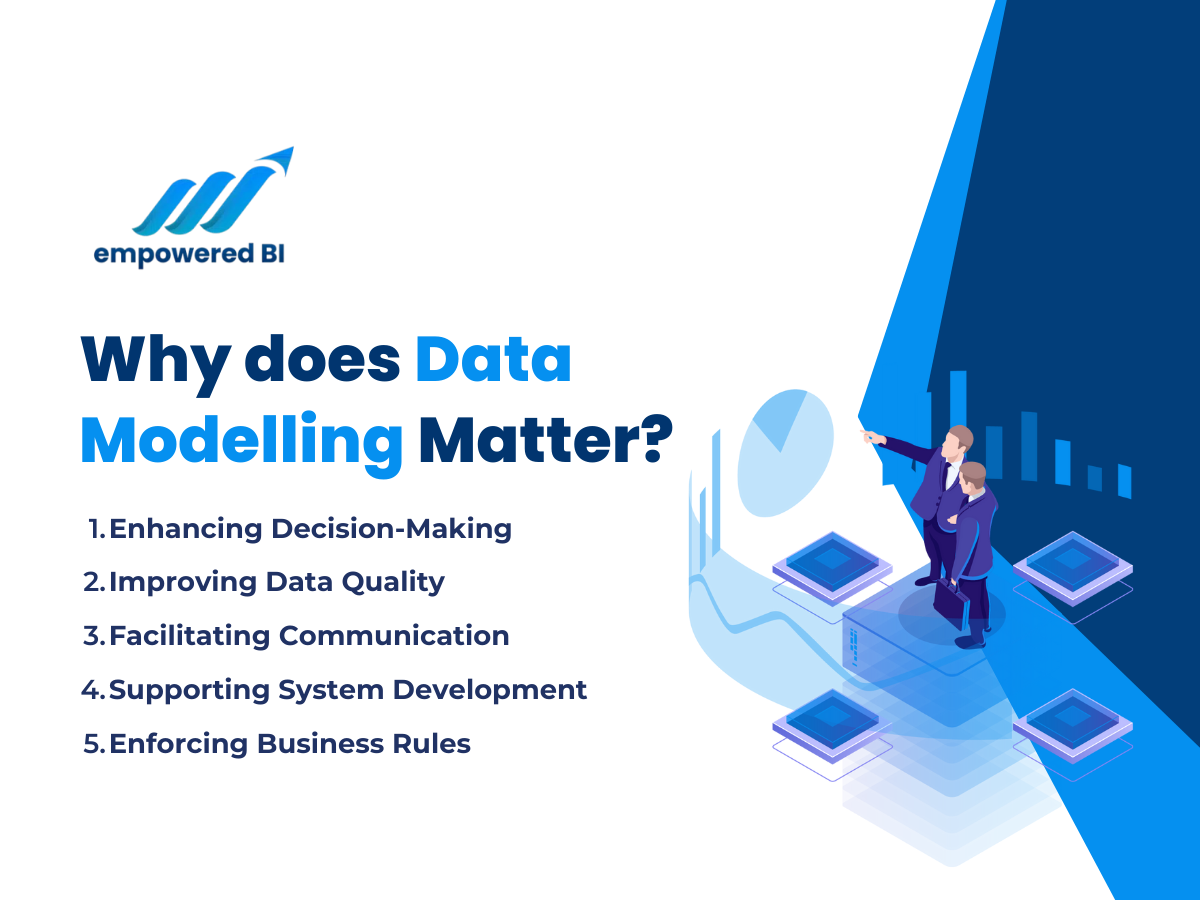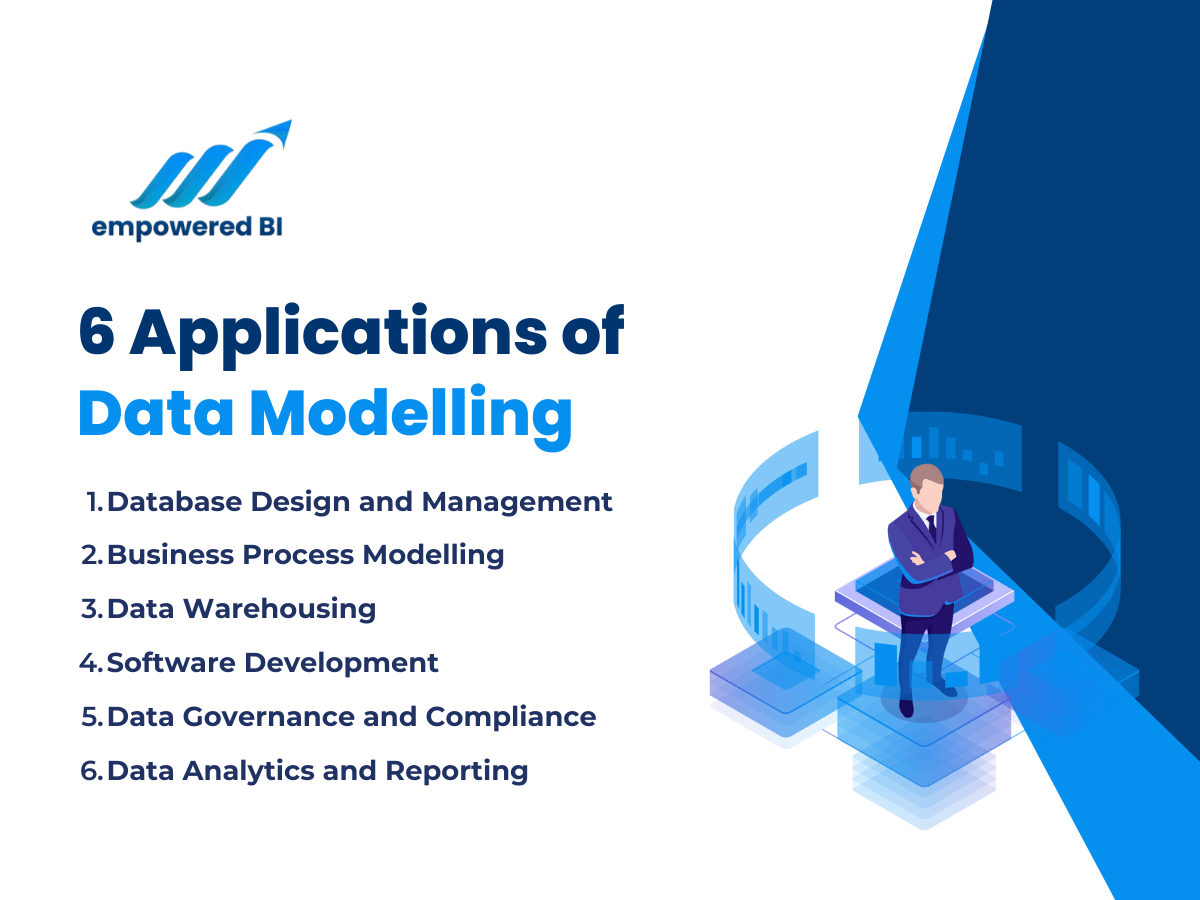In the ever-evolving landscape of data-driven decision-making, understanding the fundamentals of data modelling is paramount for anyone entering the realm of information management. Data modelling is the foundational framework that enables organisations to organise, structure, and comprehend their data meaningfully.
To help you further understand, this article will demystify the intricacies of data modelling, offering a comprehensive overview of its key concepts and principles. So, whether you’re a novice seeking to grasp the basics or an aspiring data professional looking to enhance your skills, this article will guide you through the essential elements of data modelling.
What is Data Modelling?
Data modelling is the art and science of crafting a visual representation that mirrors a dataset’s structure, organisation, and relationships. It is like an architectural blueprint guiding the construction of a robust and efficient data ecosystem. In simple terms, data modelling is designing a structure that defines how data will be stored, organised, and accessed within a database or system.
This structure enables businesses to make sense of complex datasets by establishing relationships between different entities and attributes. Fundamentally, it lays the groundwork for efficient data management and analysis. It is the foundational step in transforming raw data into meaningful insights, providing a structured framework for effectively understanding, organising, and utilising information.
Why does Data Modelling Matter?
Now that you know what data modelling means, it’s time to learn its importance. The benefits of data modelling are bountiful and far-reaching, touching various industries and professional domains. Similarly, it helps businesses through the following aspects:

Enhanced Decision-Making
As mentioned, data modelling provides a structured framework for decision-makers to interpret complex datasets. This simplified and organised data makes it easier to identify trends, patterns, and insights. This allows companies and their decision-makers to make data-based and informed decisions in their business.
Improving Data Quality
One of the fundamental aspects of data modelling is defining the rules and constraints that govern the data. This meticulous approach ensures data accuracy and consistency, improving data quality. As the saying goes, “garbage in, garbage out,” emphasising the importance of a solid foundation in data modelling.
Facilitating Communication
In collaborative environments, effective communication is paramount. Data models serve as a common language for various stakeholders. Through it, strenuous data that are hard to understand by non-technical associates are translated into more superficial and easier to understand. This bridges the gap between technical and non-technical teams.
So, whether you’re a data analyst, software developer, or business strategist, understanding data models facilitates smoother communication and collaboration.
Supporting System Development
Data modelling plays a pivotal role in developing databases and software systems. It provides a blueprint for developers, guiding the implementation of strategies that align with the organisation’s data requirements.
As such, this ensures that the systems are functional and optimised for efficient data management.
6 Applications of Data Modelling
With the benefits mentioned above, harnessing the full potential of data modelling is a must. However, to fully maximise the mentioned advantages, businesses must create a representation of data structures and the relationships between them.
Likewise, below are six critical applications of data modelling across different domains, showcasing its versatility and significance in various aspects of modern-day operations.

Database Design and Management
At the core of efficient information storage and retrieval lies a well-designed database. Data modelling plays a pivotal role in the creation and management of databases. It provides a blueprint of the database structure, defines tables, relationships, and constraints, and ensures data is organised, accurate, and accessible. This structural clarity is fundamental for effective database design.
Moreover, through this clear database structure, companies can prevent redundancies and anomalies in the database. It also helps anticipate future data requirements and enables the design of scalable databases that can evolve with the organisation’s growth.
Business Process Modelling
In the realm of business, understanding and improving processes are paramount. Data modelling extends its reach into business process modelling, aiding organisations in visualising, analysing, and optimising their workflows.
How so? Data modelling can provide companies with a visual representation of how data flows through different stages of a business process. This visualisation is instrumental in identifying bottlenecks and inefficiencies.
Moreover, data is crucial in implementing business processes. Data modelling allows for a quick and comprehensive impact analysis when changes are proposed to a business process. Organisations can assess how alterations will affect data flow and make informed decisions.
Data Warehousing
Data warehousing involves centralised data storage from various sources for analysis and reporting. Data modelling is a critical component in developing and maintaining data warehouses.
Firstly, data modelling aids in integrating heterogeneous data sources into a cohesive and unified structure within the data warehouse. This integration is essential for creating a comprehensive view of organisational data.
Moreover, dimensional modelling is a prevalent technique for organising and retrieving data in data warehousing. Data modelling helps design star or snowflake schemas, optimising the data for analytical queries.
Lastly, as business requirements evolve, data modelling facilitates modifications to the data warehouse structure, ensuring it remains aligned with organisational needs.
Software Development
Data modelling plays a pivotal role in software development, influencing the design and architecture of applications. From conceptualising data structures to optimising database interactions, its impact is felt throughout the software development lifecycle.
Remarkably, a well-designed database is the backbone of applications. Data modelling assists in creating the schema, defining relationships, and establishing constraints, ensuring the database meets the application’s requirements.
In addition, data modelling contributes to maintaining data integrity at the application level. This is crucial for preventing errors and inconsistencies in the data. Moreover, as software evolves, so do the data requirements. Data modelling supports evolutionary database design, enabling developers to change the database schema without compromising existing data.
Data Governance and Compliance
In an era where data privacy and regulatory compliance are paramount, data governance ensures that organisations manage and use data responsibly. Data modelling is a critical component of effective data governance strategies.
First and foremost, data modelling assists in defining and implementing data governance policies. This includes specifying who has access to specific data, how data is classified, and what rules govern data usage. Likewise, it allows organisations to define data quality requirements, validate data against these requirements, and implement data cleansing and enrichment processes.
Through this, companies can establish an auditable trail for data-related activities. This is essential for compliance purposes, allowing organisations to demonstrate adherence to regulatory requirements.
Data Analytics and Reporting
In the age of big data, organisations are increasingly relying on data analytics and reporting for informed decision-making. Data modelling forms the foundation for these activities, enabling practical data analysis and visualisation.
As mentioned, data modelling provides a structured framework for exploring and understanding the underlying data. Analysts can use data models to identify relevant tables, fields, and relationships for their analytical queries.
In addition, it can facilitate seamless integration with BI tools. BI requires a well-defined data model to function optimally. Data modelling can ensure accurate and meaningful insights are derived from the data.
Step-by-Step Guide to Creating a Data Model
Now that you have a foundational understanding of the importance and fundamental concepts of data modelling, let’s walk through a step-by-step guide to creating a basic data model.
Step 1: Define the Purpose and Scope. Clearly define the purpose of your data model and its scope. What questions do you want the data model to answer? What entities and relationships are relevant to your objectives?
Step 2: Identify Entities and Attributes. List the entities that will be part of your data model. For each entity, identify and define the attributes that characterise it. This step lays the groundwork for the structure of your data model.
Step 3: Establish Relationships. Determine the relationships between the identified entities. Is it a one-to-one, one-to-many, or many-to-many relationship? Clearly define how entities are connected.
Step 4: Define Keys. Establish primary keys for each entity to ensure unique identification. If your data model involves multiple tables, define foreign keys to establish relationships between them.
Step 5: Create the Initial Draft. Using your insights from the previous steps, create an initial draft of your data model. This can be a visual representation using tools like draw.io or Lucid chart or a textual representation using a data modelling language.
Step 6: Refine and Iterate. Data modelling is an iterative process. Review your initial draft, gather feedback, and refine your model. Consider factors like data normalisation to eliminate redundancy and improve efficiency.
Step 7: Validate and Test. Validate your data model by testing it with sample data. Ensure the model accurately represents the real-world scenario and can handle different use cases.
Conclusion
In the ever-evolving landscape of data-driven decision-making, understanding the fundamentals of data modelling is a crucial step for individuals entering the realm of information management. We hope that this beginner’s guide has helped you understand the complexities surrounding data modelling, shedding light on its fundamental principles and wide-ranging applications.
So, what are you waiting for? Embark on your data modelling journey with empoweredBI! Contact us now, and let us empower you with the knowledge to make your data work for you.

